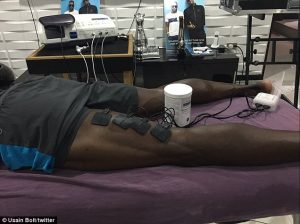With the Rio Olympics less than a month away, Usain Bolt announced last week minutes before the 100m final in the Jamaican National Championships that he was pulling out of the race due to a hamstring injury. However, not all hope is lost for Bolt, who will be given another chance to qualify for the Olympics on July 22nd at the London Anniversary Games. So what is troubling the fastest man in the world and will he be fit enough to defend his crown in Rio de Janeiro?
What are the hamstring muscles?

Tortora, Gerard J., Derrickson, Bryan. (2014). Principles of Anatomy and Physiology. Quad Graphics/ Versailles.
The hamstrings are a series of muscles that run along the posterior side, or the back of the thigh. They affect both the hip and the knee joint. There are 3 muscles that make up the hamstrings: semitendinosus, semimembranosus, and biceps femoris. All 3 muscles originate from the bottom of the pelvis bone at a projection called the ischial tuberosity and insert into the tibia and fibula which make up the shin bones from the knee down. The semitendinosus and semimembranosus work to flex the knee, extend the hip, and rotate the thigh and the knee inwards (medially). The biceps femoris serves the same function, but rotates the thigh and the knee outwards (laterally).
How does a hamstring injury occur?
Hamstring injuries are common to all athletes, but especially in sports that require a lot of sprinting, stopping, and sudden change of pace such as track and field, soccer, and rugby. During sprinting, the muscles lengthen and undergo eccentric contraction as they force the back leg to extend and push off the ground to generate force. Many injuries occur during this period when the muscle is stretched and overloaded, especially as fatigue sets in and the muscle loses the ability to absorb force (Orthoinfo, 2015). However, most hamstring injuries actually occur due to a muscle imbalance between the quadriceps muscle group and the hamstrings themselves. In fact, almost all athletes have stronger quadriceps, a series of muscles that run along the front of the thigh and serve the opposite function of the hamstrings, as their antagonists. This imbalance leads to the hamstrings not being able to tolerate the same amount of overload the quadriceps can permit and ultimately results in the hamstrings being stretched beyond their capacity.

Bolt, Usain St. Leo. (2016, July 1st). Re: Starting the recovery process right away. Retrieved from: https://twitter.com/usainbolt?ref_src=twsrc%5Egoogle%7Ctwcamp%5Eserp%7Ctwgr%5Eauthor
Muscle strains are diagnosed on a grade 1 to 3 scale; a grade 1 is usually assigned for mild strain whereas a 3 signals a complete tear or disconnection of the muscle. Luckily, Bolt was diagnosed with a mild grade 1 strain in his hamstring following his medical exemption. He later posted on his twitter page along with an image that he was receiving immediate treatment for his injury. In the image, Bolt appears to be receiving interferential current therapy (IFC) to accelerate the healing process. IFC is a form of therapy that utilizes high frequency electrical pulses to stimulate the underlying tissues and nerves through electrodes which are placed onto the affected area. IFC helps to eliminate pain, inflammation, and also stimulates natural hormones that repair injured tissues. IFC is used commonly in physiotherapy clinics to accelerate the recovery process.
Usain Bolt is battling against time to be fit for the biggest stage in athletics. No one knows how this injury will affect his performance until he is on the track. Is he still the favourite to win the Olympic title? One can only hope that the fastest man ever will have a chance to defend his crown in Rio for a record-breaking 3 straight gold medals in the 100m, 200m, and the 4´100m relays.
If you have any questions to ask a physio, email us at askburquitlamphysio@gmail.com!
Sources:
Orthoinfo. (2015). Hamstring muscle injuries. Retrieved from: http://orthoinfo.aaos.org/topic.cfm?topic=a00408

Recent Comments